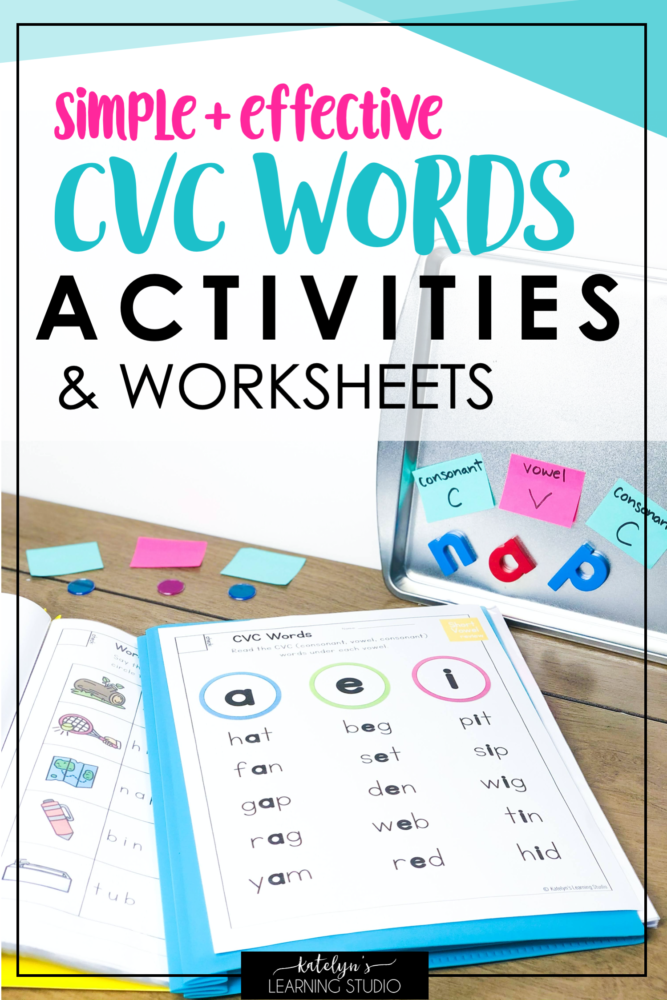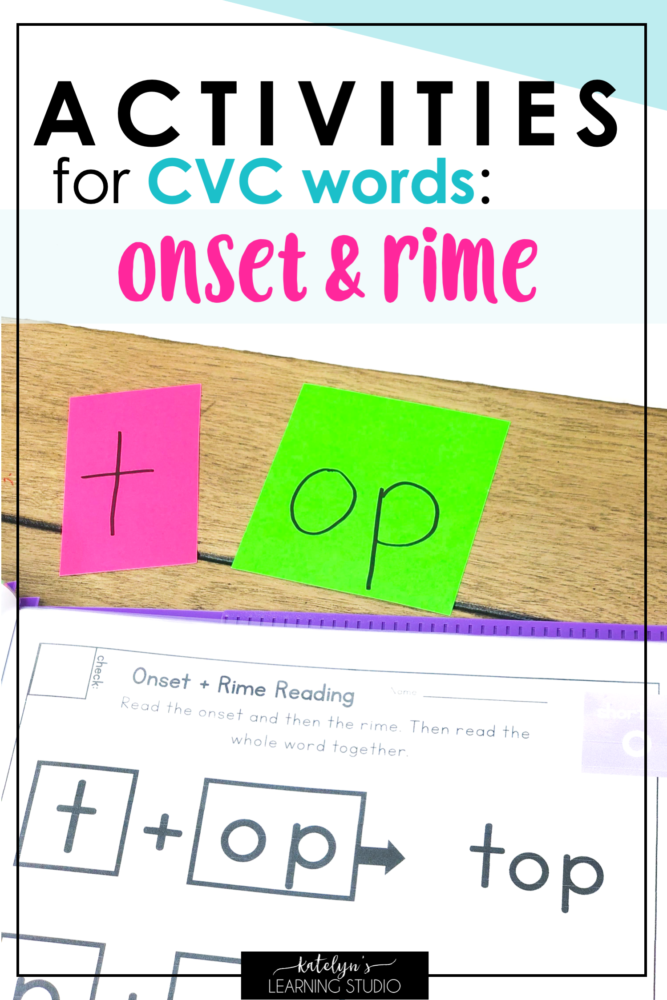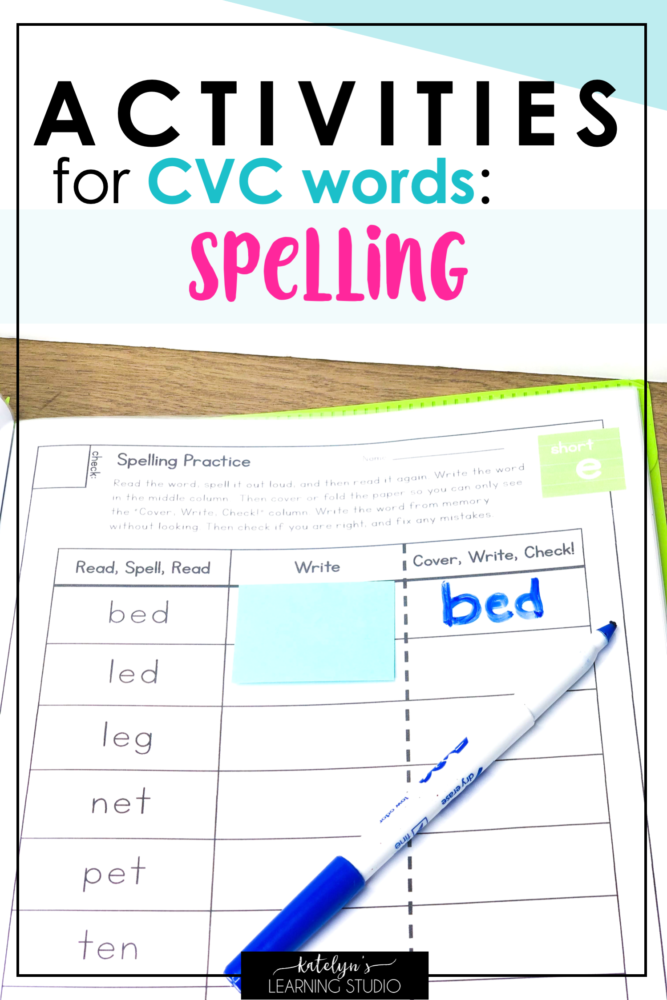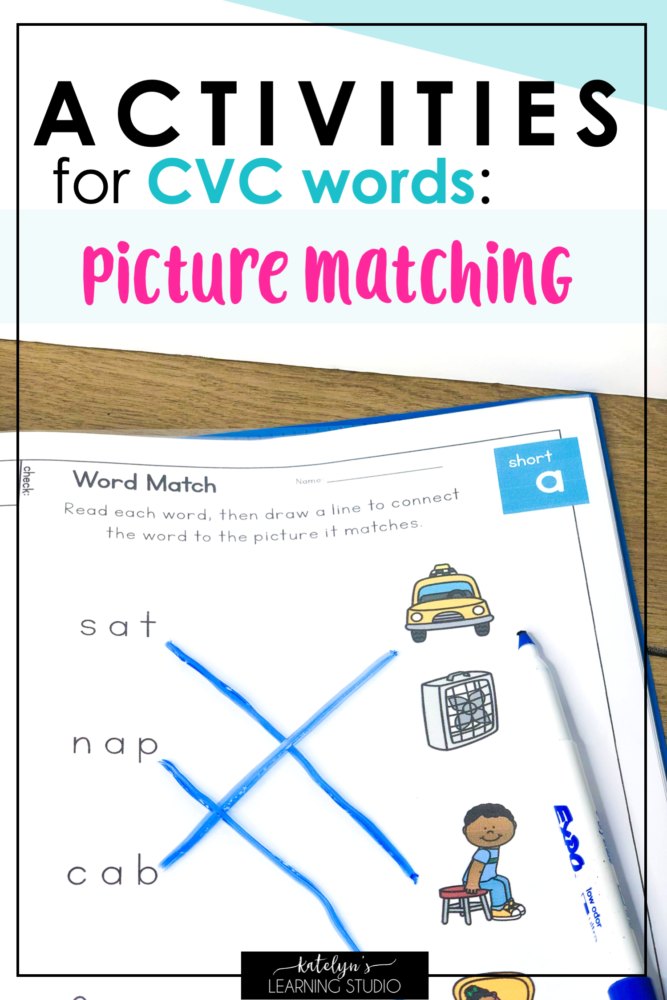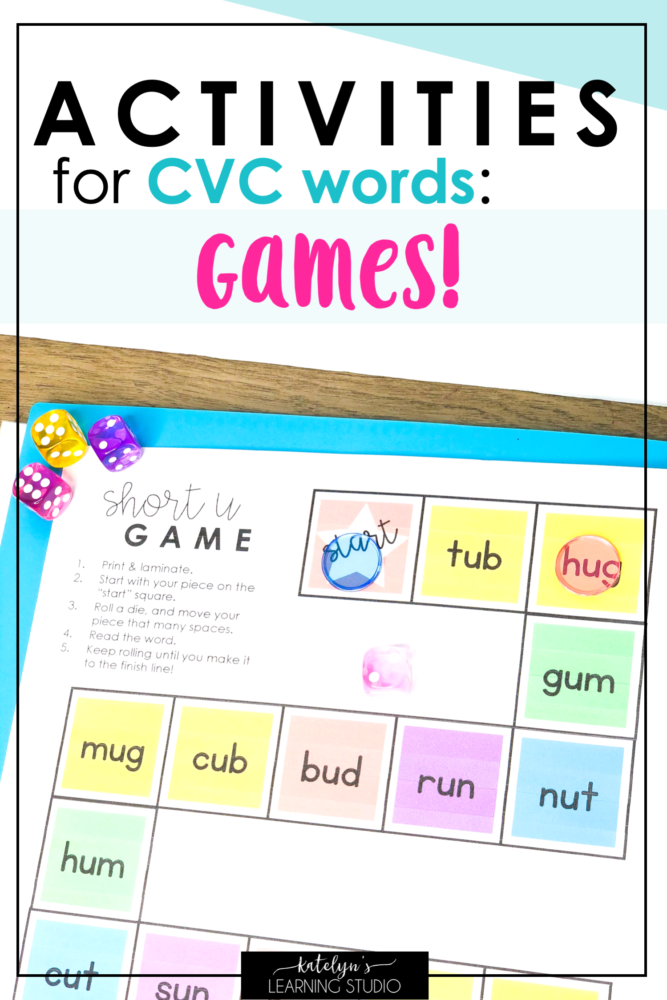The Best CVC Words Activities and Worksheets
Want to know how to teach cvc words and short vowel words easily and effectively? Here are the best activities and free worksheets for cvc words, cvc word lists, and game ideas.

Here are some activities and worksheets for cvc words that will help your readers become proficient in short vowel words.
There are a lot of ideas out there on the best ways to teach cvc words, and many of them can work wonderfully. However, there are some key components in teaching short vowel words that any activities or worksheets for cvc words should include.
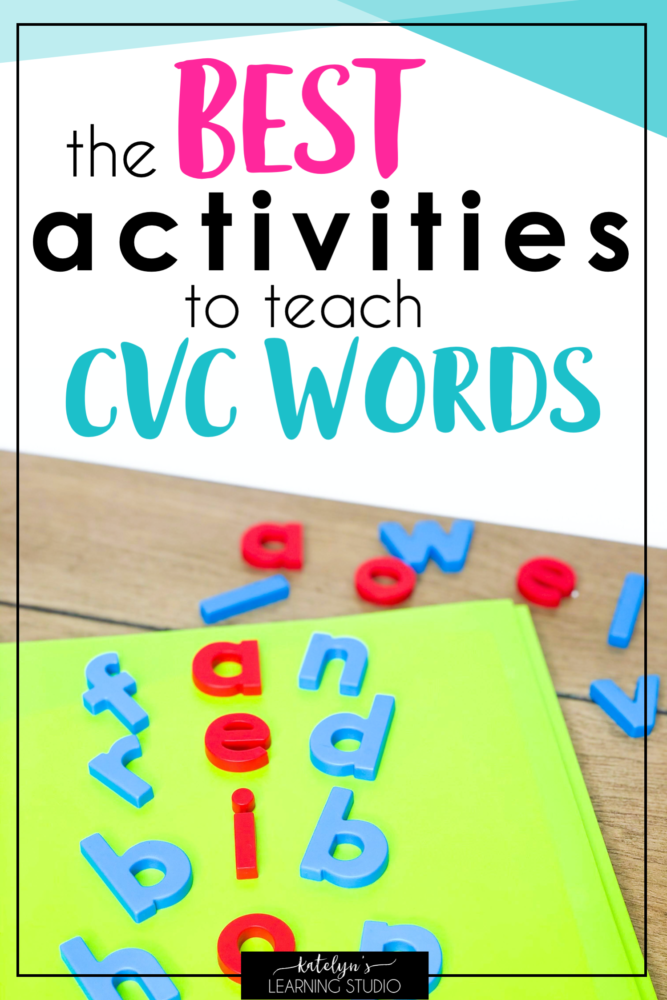
How to use effective activities for cvc words in your teaching.
What are short vowel words?
Before we get into the activities, strategies, and worksheets for cvc words, we need to understand what short vowels are.
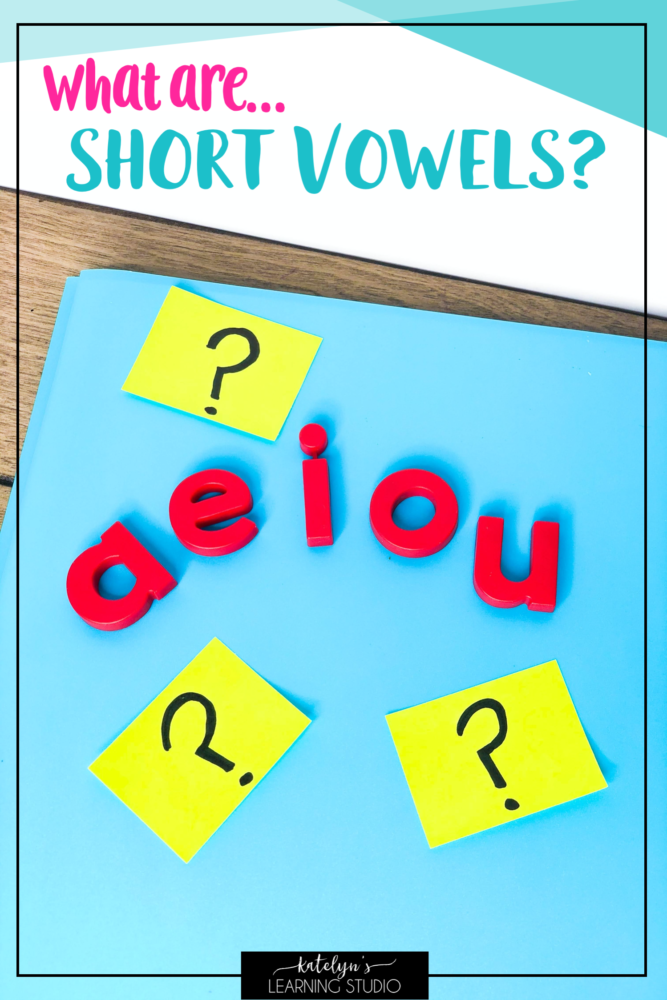
What are short vowel words? Here’s the answer!
All vowels have two basic sounds (plus other sounds, but we’ll stick to the two basic sounds first).
- Short Vowel Sounds
- Long Vowel Sounds
What is short and long vowels?
- Simply put, short vowel sounds are the more “common” sound associated with each vowel, and long vowel sounds are when the vowel says it’s own name.
- What is the difference between a short vowel and a long vowel? Short vowel sounds are usually that–short. The sound is more abrupt and cut off. The long vowel sounds have more voice and length.
- You can use short vowel symbols and long vowel symbols to help visually teach students the vowel sounds.
- Show the letter “a” with a short vowel symbol over it, and then show a different letter a with a long vowel symbol over it.
- Take a length of string and stretch it out into a straight line. Explain that this straight line is the longest the string can get, so a straight line goes over the long vowel sounds.
- Then hold up the two ends of the string and bring them closer together to make a semi-circle curve, pointed up. Show that the length of the shape got shorter, so this curved line goes over short vowels. You can even measure the two different lines as you do it so students can see one is longer and one is shorter.
- You will want to teach both the short and long vowel sounds when teaching the letter, and then focus on short vowel words first.
Examples of short vowel words
-
- Short vowel words are any word that has a short vowel sound. They can be cvc words, blends, or digraph words.
- Short vowel word examples:
- cat
- duck
- clip
- plant
- shop
- dish
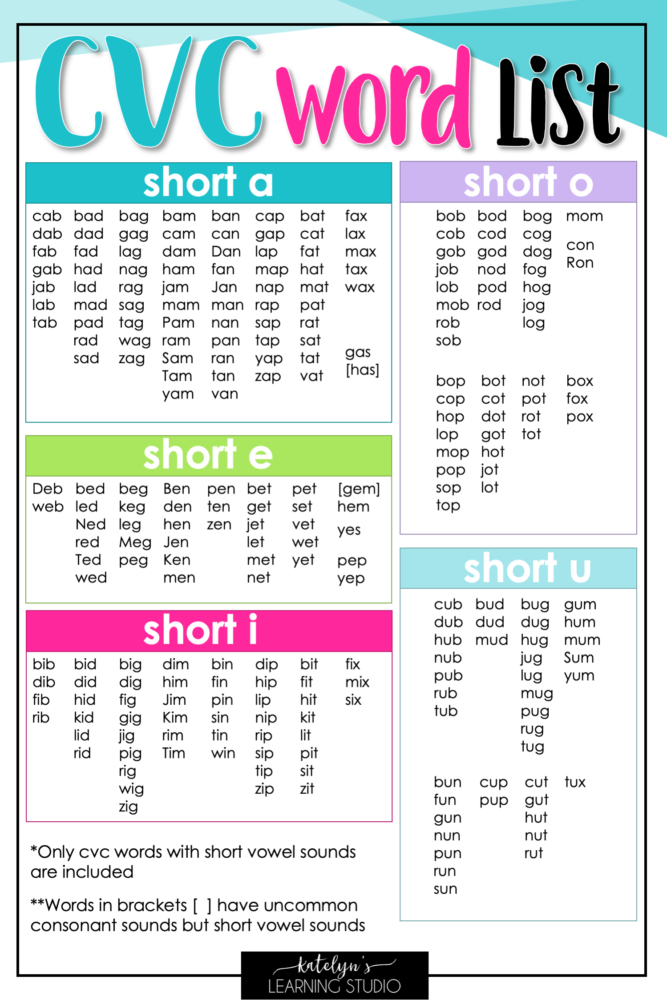
What are all the CVC words? Here’s a comprehensive cvc words list for easy reference.
What are CVC words in reading?
CVC words are a specific type of short vowel word and are usually the first type of word that students learn to read.
-
CVC words meaning:
- The “c” stands for “consonant” and the “v” stands for “vowel”. A cvc word is a word that starts with a consonant, has a vowel in the middle, and ends with another consonant. The the vowel in the middle will make its short vowel sound. For example, “cat”, “big”, and “leg” are all cvc words. When a vowel is sandwiched in between two consonants like that, it is called a closed syllable. A closed syllable almost always make the SHORT vowel sound.
-
CVC words examples:
- Examples of cvc words include:
- pan (short a cvc word)
- wet (short e cvc word)
- tip (short i cvc word)
- dog (short o cvc word)
- hum (short u cvc word)
- Examples of cvc words include:
What are all the CVC words?
-
List of cvc words
- Here is a pretty comprehensive cvc words list of most real (and appropriate) cvc words you can use to practice beginning reading skills (see the picture above). It only includes cvc words that follow the “short vowel sound” rule. If any consonants make one of their uncommon sounds (for example: gem), they are in [brackets].
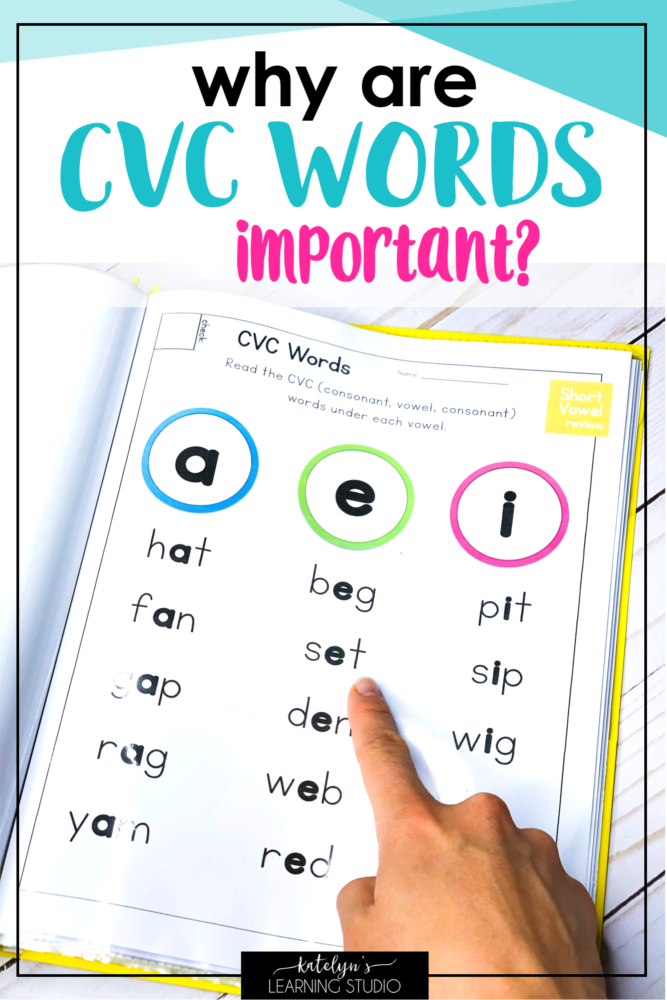
Some people wonder why are cvc words important. But let me tell you, they are! This is a page from my CVC Practice Folders.
Why are cvc words important?
- CVC words are an easy way to practice the new skills of sounding out letters and blending their sounds.
- They follow consistent rules (the consonants simply say their normal sounds and vowels always say their short vowel sounds).
- They are short words so students are less likely to get overwhelmed.
- They are the building blocks to reading bigger words. If students can easily look at and read a CVC word, they are better prepared to read the simple syllables that make up multi-syllabic words.

This graphic gives a visual sequence for how to teach CVC words, step by step.
How to Teach CVC Words
Many people just jump right into blending cvc words together, but if you follow the Science of Reading, there are very specific reading skills you need to master before you will be able to read words.
When teaching CVC words, you want to follow this basic skills progression:
- Address the pre-requisites. Make sure students…
- know their letter sounds
- are very solid on their short vowel sounds
- have basic phonemic awareness skills–identifying beginning/middle/ending sounds and blending and segmenting sounds in cvc words
- Read and put together onsets and rimes (in CVC words)
- Sound out each of the three sounds in the cvc word and put them together
- Slowly blend the sounds together as you read them out loud (slurred sounding out)
- Look at and read the whole word
One other tip for teaching CVC words is to focus on one short vowel sound at a time. First teach short a words, then short e words, then words with short o, etc. After you have gone over reading words with each of the short vowel sounds, you can end by reviewing words with mixed short vowel words. Give students words to practice that have different short vowels in them.
Multi-Sensory CVC Word Activities
Research shows that engaging multiple senses at the same time is the MOST effective way to learn. If we can get students touching, listening, speaking, and seeing while they are practicing, they will learn cvc words so much more efficiently.
🎬 Here is a video that shows some fun multi-sensory activities in action–many of which you can use with cvc words:
✨Check out this blog post for more multisensory activity ideas: 6 Fun Multisensory Learning Activities to Supercharge Your Instruction
Activities for CVC Words
There are so many activities and worksheets for cvc words out there, it can be overwhelming. However, here is a list of cvc activities you can do with your students that will actually be effective. Each of these cvc activities targets an essential skill and gives students practice that will help them progress. The key is that they address phonemic awareness, and then connect that phonemic awareness to phonics. They also start basic and build step by step on each other.
I have reading practice folders with worksheets for cvc words that cover each of these activities that you can easily print, put in page protectors in a folder, and have a research-based scaffolded way to teach reading cvc words ready to go and reuse over and over again. You can grab the whole cvc bundle here, or you can try out just the cvc words short a folder for FREE here. Alternatively, you can make your own activities that cover these same skills.
Here are a few other super effective cvc word resources you’ll love:
-
Phonemic Awareness (blending, segmenting, manipulation)
- It is ESSENTIAL to build up phonemic awareness skills to be successful in reading (see my post explaining all about phonemic awareness here). Basic blending and segmenting is all that is required to sound out cvc words, but we also want to give them the skills they need to be successful in cvc word fluency. They need to be able to manipulate (add, delete, substitute) sounds as well, in order fluently read words.
-
Onset & Rime
- Breaking words into onsets and rimes is a good stepping stone for reading cvc words. What is onset and rime? The onset is the first sound you hear in a word, and the rime is the rest of the word. For example, in “hat” the sound /h/ is the onset, and /at/ is the rime. When students practice reading onset and rime, they only have to blend two parts of the word together.
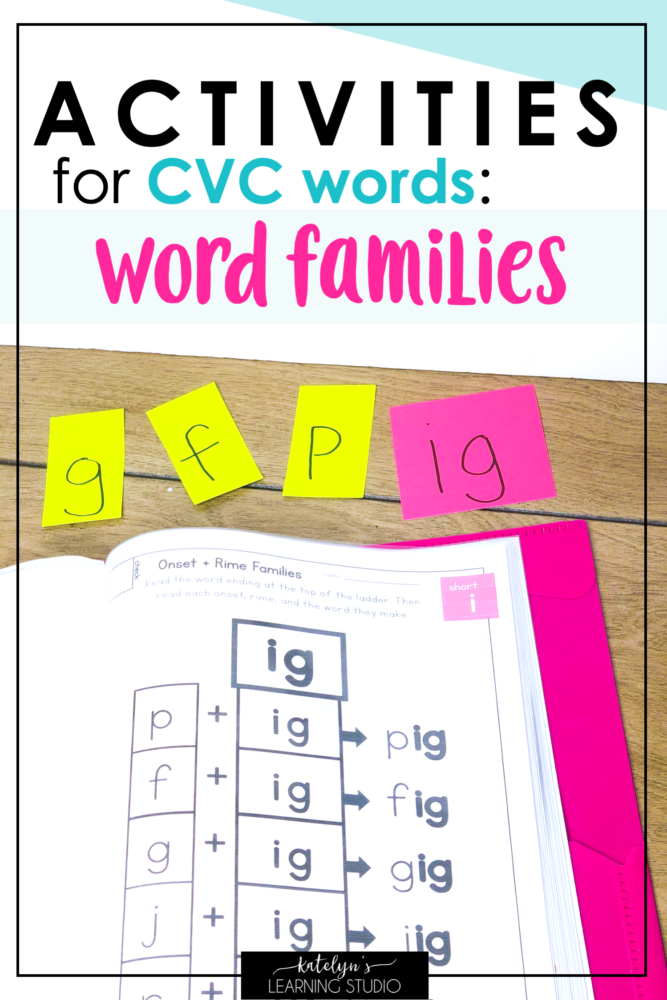
Word family worksheets are a great way to build cvc word fluency, like this page in my Short i CVC Practice Folder.
-
Word Families
- Word families is another great way to practice cvc words in a scaffolded way. The repetition of the rime means that they do not have to “re-sound out” the word ending. They can just focus on blending the new beginning sounds to the word endings.
- Click over to this blog post that gives you TONS of hands-on word family activities: 7 Word Families Activities that will Help Your Beginning Readers Soar! ✨
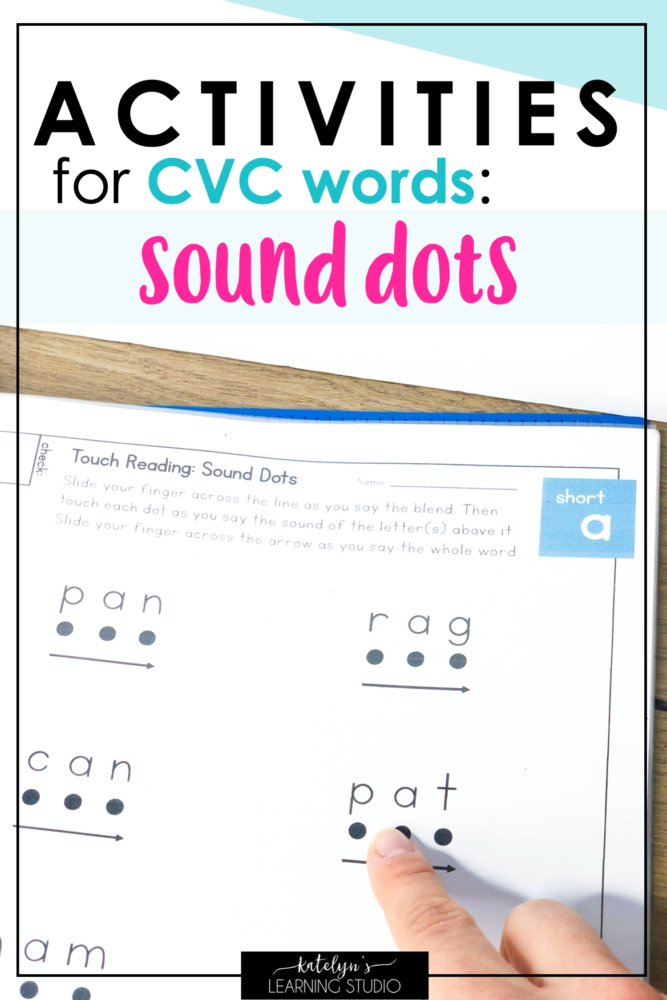
Sound dots and touch-reading make great worksheets for short vowel words. Try this worksheet out for FREE in my Short a Practice Folder!
-
Sound Dots
- I LOVE this activity. Adding the tactile plus visual aspects really help any struggling readers (I talk about ideas for incorporating different learning styles in this post too). Just put a dot under each SOUND in the word (if two letters make one sound, just put one dot under both of those letters). Then draw an arrow under the whole word. While reading, have students touch each dot and say the sound of the letter above it. Then have them say the whole word as they slide their finger across the arrow.
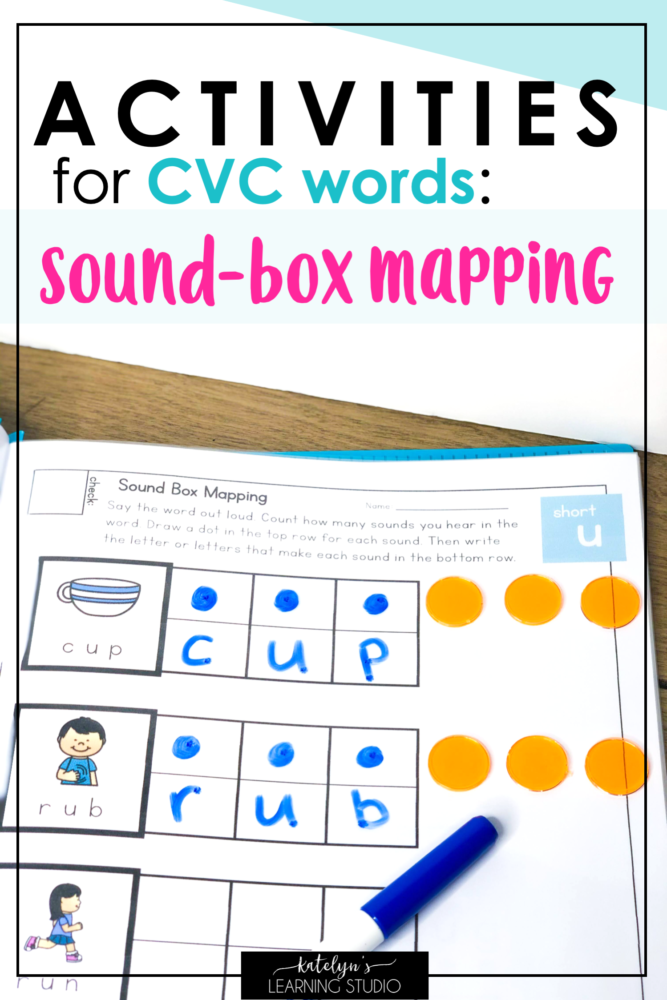
Reading intervention worksheets should focus on connecting the sounds in the words to the letters that make them.
-
Soundbox Mapping
- The goal of this activity is to get students to connect the sounds they hear in the word with the letters that represent them. This is CRUCIAL for orthographic mapping (how students learn new words and actually retain them). First you say the word. Then you count how many sounds you hear in that word. Draw one dot in each box on the top row for each sound you heard. Then underneath each sound dot, you write the letter (or letters) that make that sound. Then have the students read the word again.
-
Spelling
- Practice spelling is another way for students to connect the sounds in the words to their letters, but is less scaffolded. First, have students read the word and spell it out loud. Then have them write it again (optional: color-code the letters so the vowels or the phonics patterns stand out). Then have them cover the words and try to write the word again from memory. Last, they can uncover and check if they spelled it right, fixing any mistakes.
-
Pictures for CVC Words
- We read for comprehension (just like I explain in this blog post), so if students are reading the word without knowing what it means, two things happen. First, they are empty reading and not gaining any meaning. Second, they will not orthographically map the word and retain it for later recognition. To retain the word, students need to recognize the meaning of the word so it has a place in their schema to stay. Provide pictures for cvc words you practice, and have students match the word to the pictures. Make sure they are still sounding out and reading the word though, and not just guessing what matches the picture!
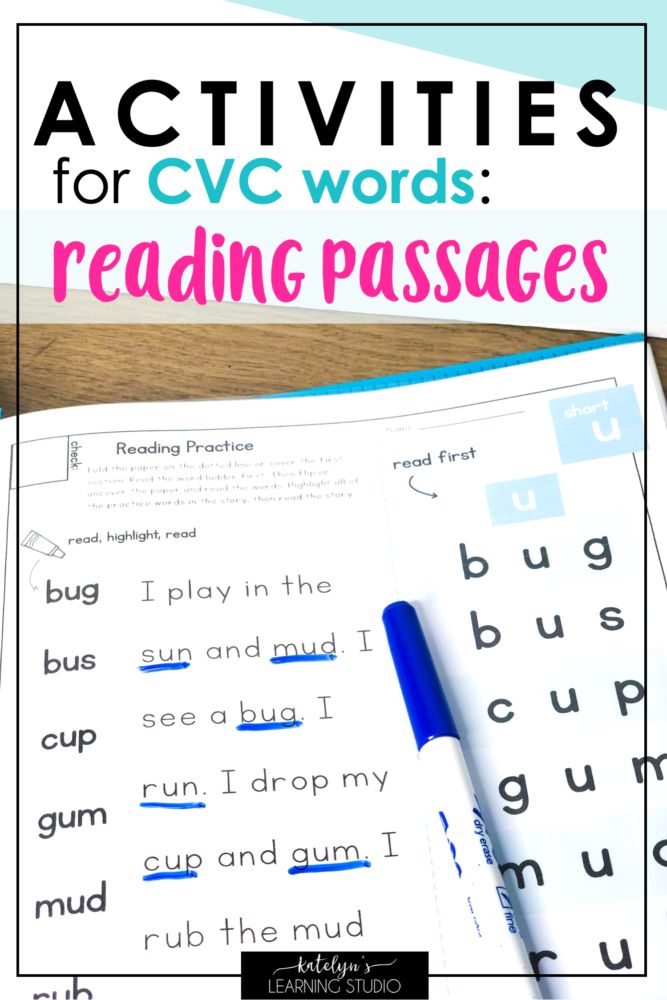
CVC word reading passages like this one in my Short u Practice Folder give students the chance to practice reading the words they’ve learned in context.
-
CVC Reading Passage
- Again, putting these words into context is crucial and cvc reading passages help students practice applying the meaning of these words to their reading. Also, key in retaining and learning new words is (obviously) spending time reading. Practice reading gives students exposure to a lot of words and helps solidify the words they have practiced. These cvc reading passages focus on the cvc words the students have practiced, plus basic sight words. They are perfect to get your kiddos to practice reading without overwhelming them!
-
Games for CVC Words
- And, last but certainly not least, is using games for cvc words in your lessons! Games are a fun way to shake things up and get students involved. They instantly ramp up excitement and, if it’s a quality game, give students a lot of exposure to your target short vowel words. One of my favorites are basic short vowel board games with short vowel cvc words written on the squares. Students roll a dice and move a game piece along the board. They can just read the word they land on, or read each word as they pass it. First to the finish wins!
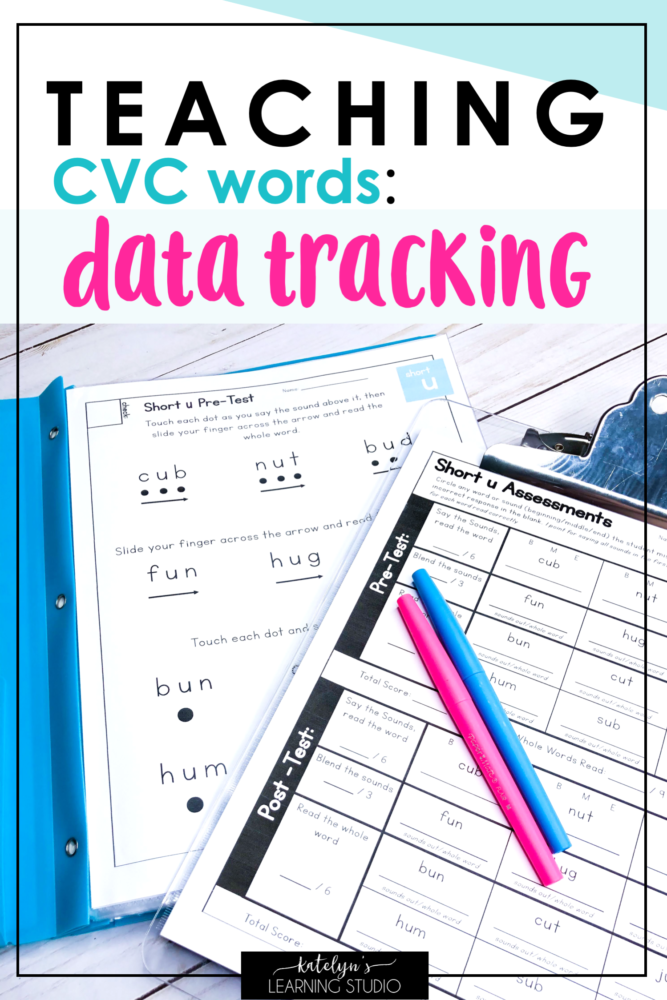
It’s important to have a cvc words assessment to keep track of student progress and pin point areas to re-target.
-
Data Tracking
- Don’t forget to keep track of student progress as you work through all of these activities. That way you are able to go back and re-target skills that they are struggling with. I love using a pre-test and a post-test to measure progress, and not just the end product.
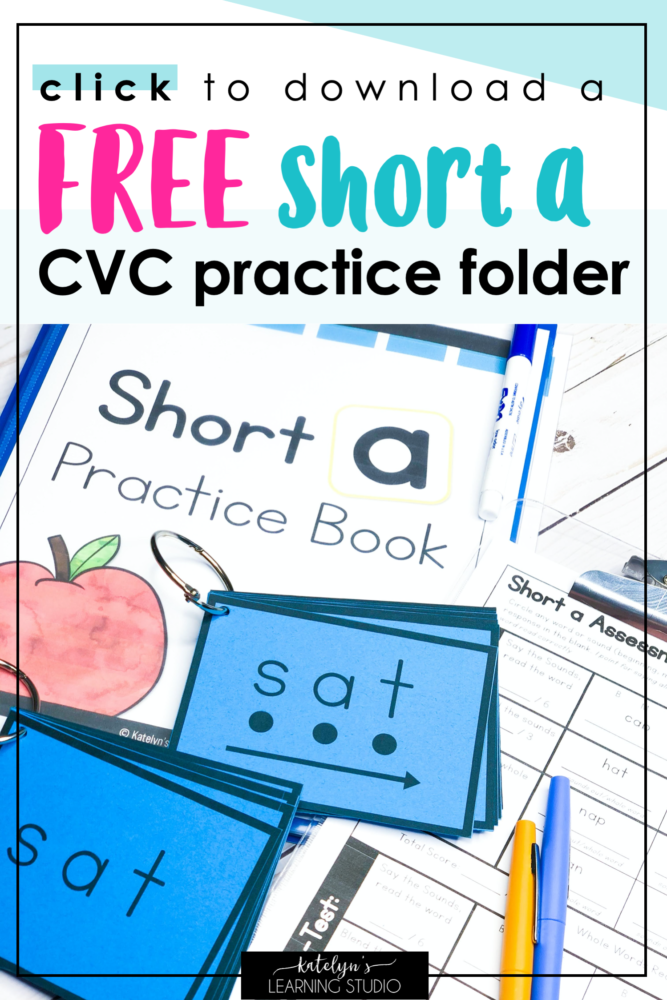
Click here to download these free worksheets for cvc short a words that are packed with effective and targeted practice activities!
Free Worksheets on CVC Words
- If you need an easy, no-prep way to practice all of these cvc reading activities, I have this AWESOME freebie for you! This cvc words short a folder has all of these targeted and effective activities ready to go for you!
CVC words short a activities
- The prep and assembly is super easy for these! Just print all of the pages out and put them in page protectors. Then, stick the pages in a plastic folder, and voila! Systematic and strategic instruction without the hassle of extra prep. You can use a dry erase marker to write on the cvc words short a worksheets, and a paper towel to wipe it off when you’re done. That way, you can re-use them over and over again!

Click here to get some amazing no-prep worksheets for cvc words in this short vowel practice folder bundle!
Worksheet for cvc words
- If you love the short a practice folder, you can target all of the other short vowel words with this CVC Words Practice Folder Bundle. Each folder includes each of the essential activities we talked about above, is super simple to prep, and is completely re-usable!
After going through all of the practice folders, your students will have such a solid base for reading cvc words and you’ll be able to see the progress with all of the data tracking sheets. Having a firm foundation in reading short vowel words will help them as they expand that skill into reading more complex words.
